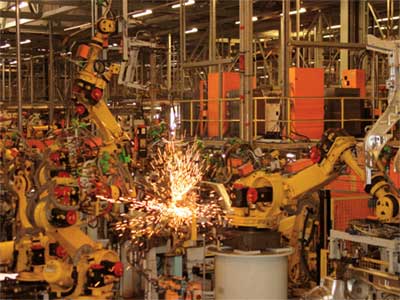|
PLEASE MATCH THE FOLLOWING TERMS WITH THEIR DEFINITIONS/DESCRIPTIONS
a. EOQ
b. Benchmarking
c. ABC
d. Operations management
e. MTO
f. MRP/MRPII
h. JIT
i. ERP
j. Taguchi Methods
l. Forecast
m. Value Added
o. ISO
p. Customisation
q. Kaizen
r. Kanban.
s. BPR
t. TQM
u. ATO
1.The effective planning, organizing and control of all the resources and activities necessary to provide the market with tangible goods and services.
2.An international, non-governmental organization, whose principal goal is to decrease trade barriers by promoting worldwide product standardization such as in manufacturing practices, paper sizes and film speeds.
3.A continuous improvement process which implies continuously trying to establish higher levels of quality by say isolating sources of problems. The ultimate aim is zero defects.
4.A complete re-evaluation and shake up of a firm with the ultimate objective of increasing it’s erformance to be more flexible, more reactive and closer in touch with the needs of the client.
5.The process of sorting and grouping products into unique combinations.
6.Management practice where the exact quantities of a product are produced or delivered just when needed.
7.Means that the manufacturer does not start to make the product until a customer’s order is received. The final product is usually made from standard items but may include custom designed components as well. Delivery lead-time is reduced because there is little design time and inventory is held as raw material.
8.The difference between what the customer pays and the cost of providing the service.
9.Are methods aimed at quality improvement in both product and process design. They are based on making designs robust by building in tolerances for manufacturing variables known to be avoidable.
10.Means that the product is made from standard components that the manufacturer can inventory and assemble according to a customer order. Delivery lead-time is reduced further because there is no design time needed and inventory is held ready for assembly.
11.The comparison of one firm’s business practices with others.
12.Approach to improving both customer satisfaction and the way organizations do business. It brings together all of the quality and customer related process improvement ideas. It is people oriented.
13.Usually refers to costing method that breaks down overhead costs into specific activities (cost drivers) in order to more accurately distribute the costs in product costing. Has also been applied to customer and vendor management.
14.An estimation of future demand.
15.Used as part of a Just-In-Time production operation where components and sub-assemblies are produced based upon notification of demand from a subsequent operation.
16.Describes software systems designed to manage most or all aspects of a manufacturing or distribution enterprise
17.Result of a calculation that determines the most cost effective quantity to order (purchased items) or produce (manufactured items). The formula basically finds the point at which the combination of order cost and carrying cost is the least.
18.Process for determining material, labor and machine requirements in a manufacturing environment. |


